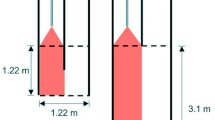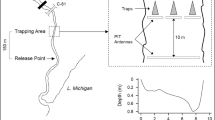Abstract
In previous experiments, chemical stimuli from northern pike (Esox lucius) elicited fright responses from pike-naive fathead minnows (Pimephales promelas) only if the pike had recently eaten conspecific minnows. We used a behavioral assay to determine if the fright response is the result of the incorporation of the minnow alarm pheromone into the chemical signature of the pike. Because the alarm substance cells (epidermal club cells) of fathead minnows are seasonally lost by males, we used chemical stimuli from pike that had eaten breeding male minnows as a control stimulus. In independent laboratory and field experiments, pike-naive minnows exhibited fright reactions (e.g., increased shelter use, avoidance) when exposed to water from tanks containing pike that had eaten nonbreeding fatheads (with alarm substance cells), but not to water from tanks containing pike that had eaten breeding male fatheads (without alarm substance cells). These data indicate that the fathead minnow alarm pheromone chemically labels northern pike as dangerous to pike-naive receivers.
Similar content being viewed by others
References
Blum, M.S. 1985. Alarm pheromones, pp. 193–224,in G.A. Kerkut and L.I. Gilbert (eds.). Comparative Insect Physiology, Biochemistry, and Pharmacology, Vol. 9. Pergamon Press, Sydney.
Crowl, T.A., andCovich, A.P. 1990. Predator-induced life-history shifts in a freshwater snail.Science 247:949–951.
Hews, D.K. 1988. Alarm response in larval western toads,Bufo boreas: Release of larval chemicals by a natural predator and its effect on predator capture efficiency.Anim. Behav. 36:125–133.
Howe, N.R., andHarris, L.G. 1978. Transfer of the sea anemone pheromone, anthopleurine, by the nudibranchAeolidia papillosa.J. Chem. Ecol. 4:551–561.
Keefe, M. 1992. Chemically mediated avoidance behaviour in wild brook trout,Salvelinus fontinalis: The response to familiar and unfamiliar predaceous fishes and the influence of fish diet.Can. J. Zool. 70:288–292.
Keefe, M., Whitesel, T.A., andWinn, H.E. 1992. Learned predator avoidance behavior and a two-level system for chemosensory recognition of predatory fishes in juvenile brook trout, pp. 375–381,in R.L. Doty and D. Müller-Schwarze (eds.). Chemical Signals in Vertebrates, Vol. 6. Plenum, New York.
Lawrence, B.J., andSmith, R.J.F. 1989. Behavioral response of solitary fathead minnows,Pimephales promelas to alarm substance.J. Chem. Ecol. 15:209–219.
Lawrence, J.M. 1991. A chemical alarm response inPycnopodia helianthoides (Echinodermata: Asteroidea).Mar. Behav. Physiol. 19:39–44.
Magurran, A.E., andGirling, S.L. 1986. Predator model recognition and response habituation in shoaling minnows.Anim. Behav. 34:510–518.
Magurran, A.E., andPitcher, T.J. 1987. Provenance, shoal size and the sociobiology of predatorevasion behaviour in minnow shoals.Proc. R. Soc. London Ser. B 229:439–465.
Mathis, A., andSmith, R.J.F. 1992. Avoidance of areas marked with a chemical alarm substance by fathead minnows (Pimephales promelas) in a natural habitat.Can. J. Zool. 70:1473–1476.
Mathis, A., andSmith, R.J.F. 1993a. Fathead minnows (Pimephales promelas) learn to recognize pike (Esox lucius) as predators on the basis of chemical stimuli from minnows in the pike's diet.Anim. Behav. In press.
Mathis, A., andSmith, R.J.F. 1993b. Intraspecific and cross-superorder responses to chemical alarm signals by brook stickleback.Ecology In press.
Mathis, A., Chivers, D.P., andSmith, R.J.F. 1993. Population differences in responses of fathead minnows (Pimephales promelas) to visual and chemical stimuli from predators.Ethology 93:31–40.
Pfeiffer, W. 1963. The fright reaction in North American fish.Can. J. Zool. 41:69–77.
Pfeiffer, W. 1974. Pheromones in fish and amphibia, pp. 269–296,in M.C. Birch (ed.). Pheromones. Frontiers of Biology, Vol. 32. Elsevier/North-Holland, Amsterdam.
Pfeiffer, W. 1977. The distribution of fright reaction and alarm substance cells in fishes.Copeia 1977:653–665.
Purrington, F.F., Kendall, P.A., Bater, J.E., andStinner, B.R. 1991. Alarm pheromone in a gregarious poduromorph collembolan (Collembola: Hypogastruridae).Great Lakes Entomol. 24:75–78.
Ressler, R.H., Cialdini, R.B., Ghoca, M.L., andKleist, S.M. 1968. Alarm pheromone in the earthwormLumbricus terrestris.Science 161:597–599.
Rittschof, D., Tsai, D.W., Massey, P.G., Blanco, L., Kueber, G.L., Jr., andHaas, R.J., Jr. 1992. Chemical mediation of behavior in hermit crabs: Alarm and aggregation cues.J. Chem. Ecol. 18:959–984.
Siegel, S. 1956. Nonparametric Statistics for the Behavioral Sciences. McGraw-Hill, New York.
Siegel, S., andCastellan, N.J., Jr. 1988. Nonparametric Statistics for the Behavioral Sciences, 2nd ed. McGraw-Hill, New York.
Smith, R.J.F. 1973. Testosterone eliminates alarm substance in male fathead minnows.Can. J. Zool. 51:875–876.
Smith, R.J.F. 1974. Effects of 17α-methyltestosterone on the dorsal pad and tubercles of fathead minnows (Pimephales promelas).Can. J. Zool. 52:1031–1038.
Smith, R.J.F. 1976. Seasonal loss of alarm substance cells in North American cyprinoid fishes and its relation to abrasive spawning behaviour.Can. J. Zool. 54:1172–1182.
Smith, R.J.F. 1986. The evolution of chemical alarm signals in fishes, pp. 99–115,in D. Duvall, D. Müller-Schwarze, and R.M. Silverstein (eds.). Chemical Signals in Vertebrates, Vol. 4. Plenum, New York.
Smith, R.J.F. 1992. Alarm signals in fishes.Rev. Fish Biol. Fish. 2:33–63.
Smith, R.J.F., andMurphy, B.D. 1974. Functional morphology of the dorsal pad in fathead minnows (Pimephales promelas Rafinesque).Trans. Am. Fish. Soc. 103:65–72.
Smith, R.J.F., andSmith, J.D. 1983. Seasonal loss of alarm substance cells inChrosomus neogaeus, Notropis venustus andN. whipplei.Copeia 1983:822–826.
Waldman, B. 1982. Quantitative and developmental analyses of the alarm reaction in the zebra danio,Brachydanio rerio.Copeia 1982:1–9.
Zar, J.H. 1984. Biostatistical Analysis, 2nd ed. Prentice-Hall, Englewood Cliffs, New Jersey.
Author information
Authors and Affiliations
Rights and permissions
About this article
Cite this article
Mathis, A., Smith, R.J.F. Chemical labeling of northern pike (Esox lucius) by the alarm pheromone of fathead minnows (Pimephales promelas). J Chem Ecol 19, 1967–1979 (1993). https://doi.org/10.1007/BF00983800
Received:
Accepted:
Issue Date:
DOI: https://doi.org/10.1007/BF00983800




